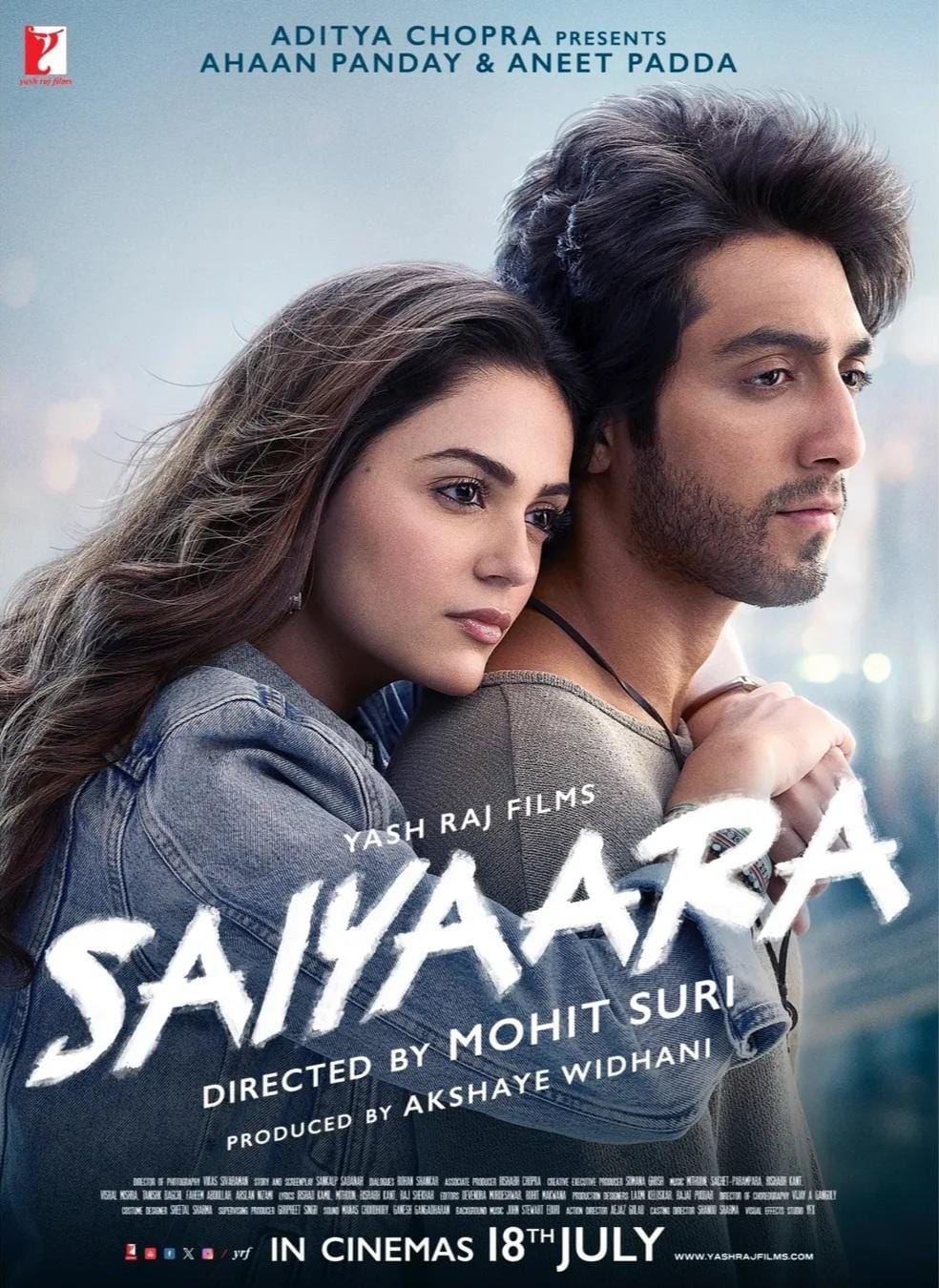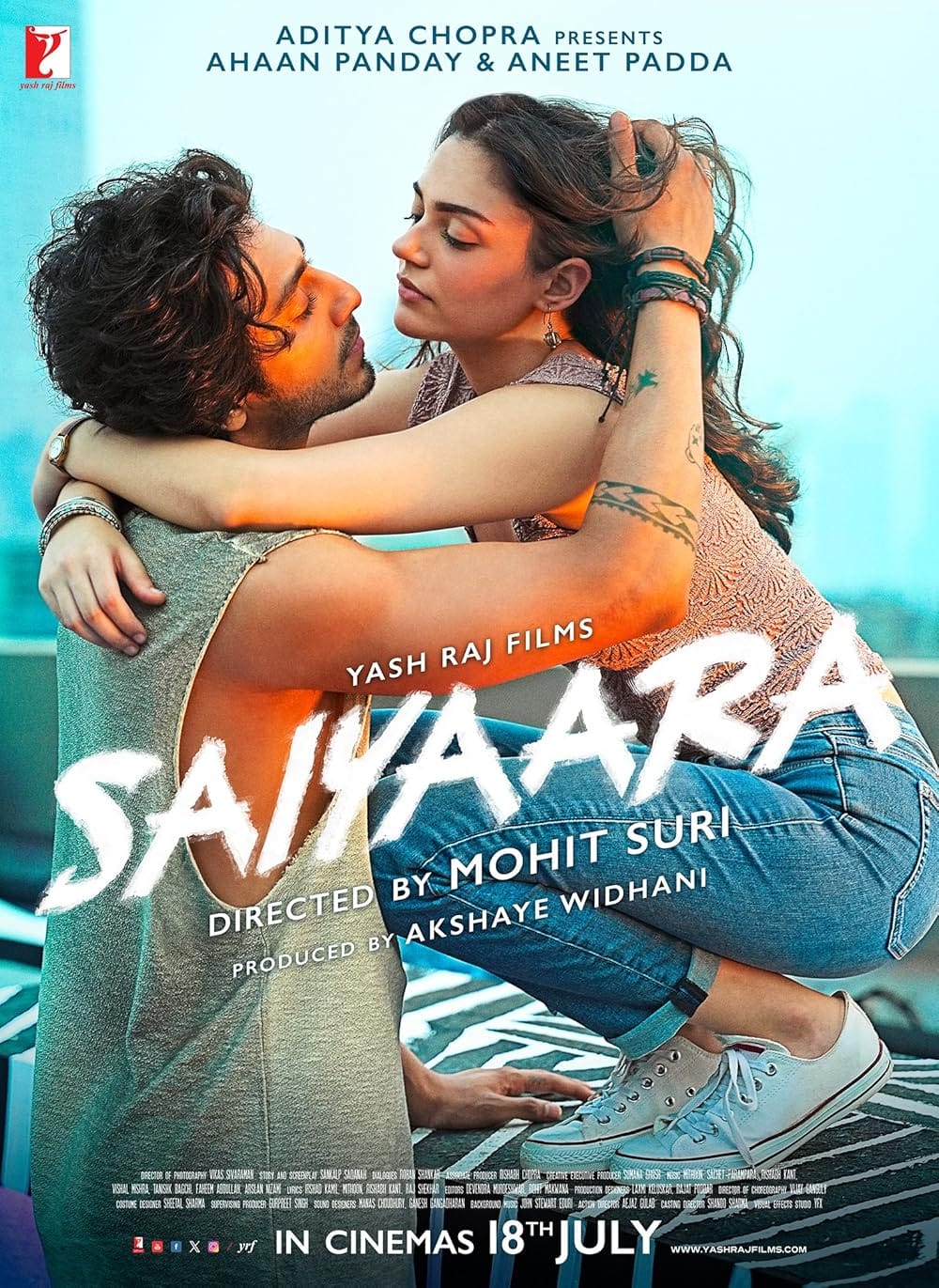It has now been a week since Mohit Suri’s latest offering, Saiyaara (2025), hit the big screens. During these seven days, the film has managed to rack up some serious numbers at the box office, figures that have astounded both critics and audiences alike. After all, when was the last time new faces like these became such instant darlings of the box office? Filmed on a modest budget of less than Rs 40 crores, Saiyaara has quickly risen through the ranks to become one of the top five highest-grossing films of 2025.
Initially conceptualised as part of Suri’s “Ashiqui” series, Saiyaara has enjoyed a consistent footfall even after its opening weekend and is now projected to surpass, as it happens, crowd-favorite Aamir Khan’s own Sitaare Zameen Par (2025). Are these box-office successes to do with star-studded titles, or are they a fate written in the stars? One can only choose to wonder. Despite a marked lack of widespread promotions and a shoddy trailer that hardly comes to represent the film, what then could be attributed to Saiyaara’s stupendous success?
Criticism from the commodes
Consider this conversation, overheard from within a toilet stall during Saiyaara’s Intermission:
Three young girls linger near the mirror area of a local theatre’s washroom, reapplying lip gloss, taking mirror selfies, presumably to wile away time before their fourth friend, who occupies one of the only two functioning toilet stalls, rejoins their small group.
GIRL 1
It is a little predictable, isn’t it?
GIRL 2
Yes, I don’t really understand the hype—
GIRL 3
Not predictable, exactly, but its like three Wattpad plots built into one
GIRL 2
Yes, like a saas-bahu show that never ends
Giggles break out. The sound of a flush in the background. GIRL 4 exits her toilet stall.
GIRL 4
But somehow it’s still fun, na? I’m so invested…
A murmur of agreement does the rounds, some sheepish, some more enthusiastic.
What do these girls mean when they call Saiyaara’s fictional plot similar to fanfiction? Why do they seem to be having fun in spite of this overfamiliarity with the plot? Why does Saiyaara feel predictable in the way that fanfiction can be, and how is it at the same time compared to Indian soap operas that are well-known for their outlandish plot devices and deus ex machinas? What could Wattpad fanfiction and saas-bahu shows have in common in the first place? Perhaps it is this very plot that might serve as answers.
The plot thickens
Saiyaara’s plot takes in stride everything director Mohit Suri is best known for. Continuing on the legacy left behind by his earlier almost-cult favorite Aashiqui 2, the story follows a rising musician tormented by the demons of his past, and a talented writer who has just experienced a devastating heartbreak of her own.
On the surface of things, Saiyaara’s plot is as quintessential as it gets. The girl and the boy meet and fall in love, until the world and its tragic circumstances intervene to prevent their inevitable “happily ever after.” It is a tale as old as time. Whether it is Veer Zara set against the hauntings of the Partition, or the genre-defining romantic drama Dilwale Dulhania Le Jayenge, where tradition and modernity butt heads in an India at the turn of the century, Saiyaara is yet another variation of the same old story we have seen and loved countless times in the past.
This is hardly the case with Bollywood alone. Some of our most beloved and retold stories have often boasted the same general plot. Think Romeo and Juliet, or Heer-Ranjha, or even Laila and Majnu. This classic story of love told via separation has been of deep fascination to the world at large, and more so in India, specifically. It is only in very recent times that the genre of the tragic romance has been found under decline, overtaken by a surge in war plots, murder mysteries, and the “based on a true story” biopic genre. This is perhaps why Saiyaara resonates with its audience as much as it has been able to: not despite the familiarity of its plot, but because of it.
However, the familiarity of the plot structure hardly stages Saiyaara to be an ultimately predictable film.
However, the familiarity of the plot structure hardly stages Saiyaara to be an ultimately predictable film. The major conflict of the film emerges towards the middle of the second act, when the female protagonist, the quiet and shy Vaani (Aneet Padda), is diagnosed with Early Onset Alzheimer’s, a condition so rare the film pauses its fantastical narrative to tell us explicitly that while chances are less than 0.4%, there has indeed been a precedented case of a seventeen year old Chinese girl. From then on, the film continues to map the many complications that become the barrier between the ambitious rogue of a rockstar Krish, and the swiftly worsening Vaani.
And boy, are the twists and turns something! Among the many melodramatic events that make up the plot of this film, they include frequent fainting spells, the return of an evil ex in the shape of an inescapable investor, the female protagonist stabbing (!!!) the male protagonist, albeit in a bout of forgetfulness, and most unbelievable of them all, a nonchalant set of parents who seem completely unfazed by their daughter jaunting off to Goa with her bad-boy beau and his fancy motorbike.
At no point does Saiyaara leave its audience’s suspension of disbelief untested. So while the direction and the performances are indeed stellar, as has been reported by most critical accounts of the film, there is a considerable amount of work that any audience watching Saiyaara must do to patch up the many leaps of fancy its plot takes.
Saiyaara’s dual-edged legacy
Despite this unusual degree of unreality marking its progressions, however, filmgoers have taken to the internet to voice their many words of praise. The many adjectives lavished upon Saiyaara included “heart-touching,” “tear-jerking,” “emotionally wrought,” and more often than not, “relatable.”
But just what about this shy writer-rockstar duo feels relatable to an audience that presumably belongs to neither of these two categories? What about Early Onset Alzheimer’s disease, one the film itself calls rare, makes the audience feel represented on screen? What about the many dramatic twists and turns Saiyaara’s plot takes, make it appealing to the mundanities of daily lives? To look for answers, one must perhaps look for answers beyond merely the plot of Saiyaara.
While most critics’ accounts have few bones to pick with Saiyaara, the occasional complaints have risen with respect to an underwritten female protagonist and the general intensity and improbability of the plot line. Popular film critic Sucharita Tyagi argues, for example, ‘Vaani as a character is given very little to do beyond being devastated. Things only happen to her. She is rarely allowed to willingly participate.’
Popular film critic Sucharita Tyagi argues, for example, ‘Vaani as a character is given very little to do beyond being devastated. Things only happen to her. She is rarely allowed to willingly participate.’
This is a strange protest to make about a film that overtly positions itself as being about two star-crossed lovers, hence the title, and thereby about destiny. If the female protagonist is claimed to be given little to do, so is, by that metric, the male lead. In a story about tragedy, often, the affect that seems to attach to all its primary characters is that of helplessness, something beyond their individual existences that cannot be helped within themselves.
Not only does this comment not take its subject, the film, seriously, but it is also factually incorrect for the most part: Vaani drives the narrative and its central conflict. She’s a fantastic writer, which becomes the premise of the lovers’ meet-cute. She hides her diagnosis from all her family and friends, which ushers the film from its first act into the second. She runs away from home, which becomes the final pinch point in the third act, ensuring their separation and thereby keeping the audience rooted to their seats. And are we forgetting that she stabs (!!!) her lover, amnesia or not?
Agency is never the central question that guides a well-written character in cinema, because a screenplay depends upon a play of actions and reactions, or rather, incidents that occur and how the protagonists respond to them. This relationship is highlighted even more so in films about star-crossed lovers, where it is precisely their lack of agency and their helplessness that seems to hold critical emotional appeal for an audience. There is something to be said here about the curious cycle that has emerged between films and their criticism in contemporary Bollywood.
More and more, we see that rather than the films, it is their criticism that has become cookie-cutter in nature. It is equally true that filmmakers, in their blind hunger for a good critical reception, have learnt the contours of this cookie-cutter all too well, resulting in a barrage of films tacked on high to their soap box. It is far too easy to dismiss mass-scale entertainers like Saiyaara as melodramatic and over-the-top, without necessarily engaging with why it might appeal to an audience in the way it does.
Many YouTube users took to the comment sections under Tyagi’s video review, touting how much they enjoyed the film. ‘After having an onslaught of high action or ‘mass’ movies stuffed with VFX or non-actors being given too many chances… This was a relief. Why I liked it… I think it’s the nostalgia of a basic, totally predictable love story,‘ said one user.
Many YouTube users took to the comment sections under Tyagi’s video review, touting how much they enjoyed the film.
Another claimed, ‘I like you, Sucharita, I really do. However, I needed this ‘outdated’ love story, which we have probably seen a thousand times.‘
Yet another user suggests, ‘At least we got to talk about a Hindi film in our office after ages,‘ and that she had highly missed the exhilaration such an activity entailed.
Fantasies abhi…baaki hai, mere dost
The divide between the critical approach and the audience response is marked, and brings up interesting questions to the conversation so far: What is the role of art and cinema? Is it to produce a moral awakening in the masses, which films like Sitaare Zameen Par offer? Is it to act as a mirror to reality, like most of today’s slice of life and “based on a true story”-esque films claim to do? Or is it to provide a larger-than-life canvas for escapist fantasies, as Bollywood’s “unrealistic” film plots have attempted to do since time immemorial? And what is the role of art criticism in this mix? Is it merely to produce judgements over the goods and the bads of the film and its technical aspects? Or is it also to understand how and why a film might resonate with the general audience itself?
The answers lie beyond the fanciful flights of Saiyaara, in the very real world that it was released into. In an era of sterile action franchises and biopics that mistake accuracy for art, Saiyaara‘s success is a referendum on what audiences are truly starved for: unabashed feeling. To critique the film for its lack of realism is to miss this point entirely.
Films like Saiyaara are far from a mirror to our daily lives. Its fantastical plot and high-stakes romance function like a modern myth, providing a grand, familiar structure for our own messy and often inexplicable desires. For all its unbelievable twists, the film is anything but afraid, and its relatability comes not from its story, but from its feeling— a recognition that love, at its core, has always felt a little larger than life.
About the author(s)
Ananya is a writer and researcher of all things literature. With a particular emphasis on film, gender, and sexuality, she is great at curating the perfect movie night, but when it comes to life itself, she's still figuring out the script.










That’s an interesting take! We’ll articulated.
I LOVE THE WAY YOU WRITE NANYA !!!!! (loved the star puns) keep goinggggg!